
GPS fleet tracking gives any business enterprise-level management tools that improve your bottom line and lead to better performance from your team. In many cases, employees are happy to benefit from the many advantages offered by fleet tracking, but there is a chance that an employee may raise objections you’ll need to address.
For your fleet tracking rollout to be successful, you need to approach the topic carefully and make sure you communicate both the benefits and expectations associated with the new technology. With the right preparation and knowledge, you can get all employees on the same page when it comes to your new GPS tracking policy.
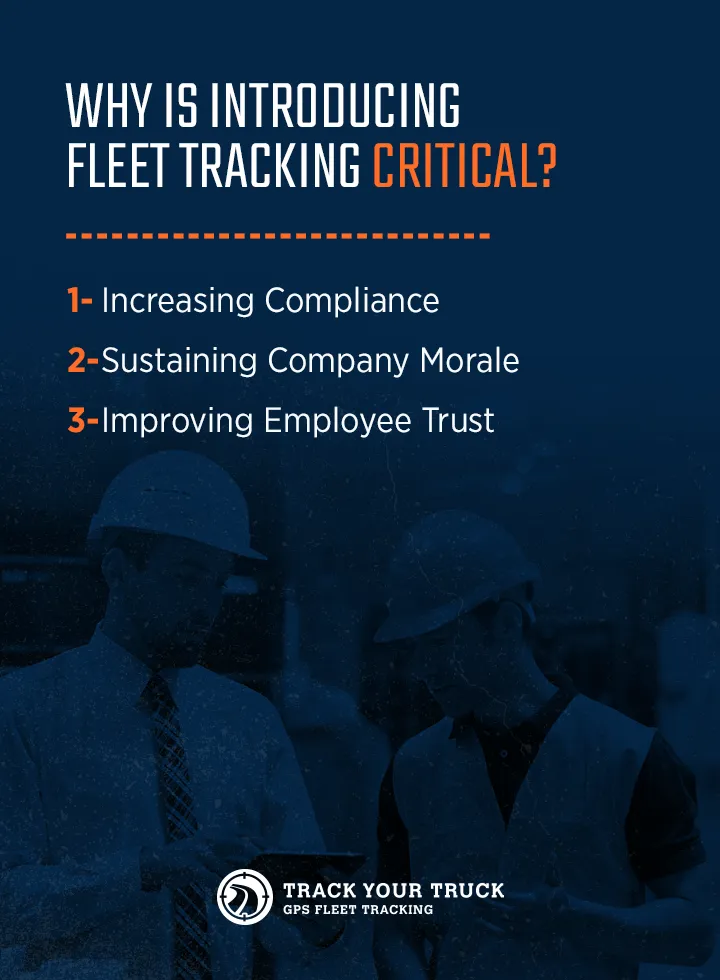
You could choose not to formally introduce fleet tracking to your team of drivers, or take the path of least resistance by offering up the information via email. However, you’d lose out on the many benefits of a formal introduction. These three benefits can make a big difference in the success of your fleet tracking program.
When employees aren’t aware of new technology and the policies that go along with it, they can’t comply with the new rules. An introduction to your new fleet tracking system should give every employee the information they need to perform the way you want them to. Communicating fleet management expectations at the outset gives everyone a chance to ask questions and clarify any confusing points beforehand.
Without a proper introduction, employees may feel like fleet management software is a punishment of some kind. A good introduction will clearly explain company motives for implementing the program so drivers don’t feel threatened by the new technology. Your introduction is also an opportunity to explain how GPS tracking directly benefits drivers as well as the fleet manager and company overall.
Employees appreciate when management takes the time to explain new tech and how it will affect their jobs day-to-day. Intentionally providing a thorough introduction to fleet tracking gives you the chance to prove that you have employees’ best interests at heart and aren’t trying to spring something negative on them just to make extra money. Garnering that kind of trust from employees helps boost compliance and morale as well.
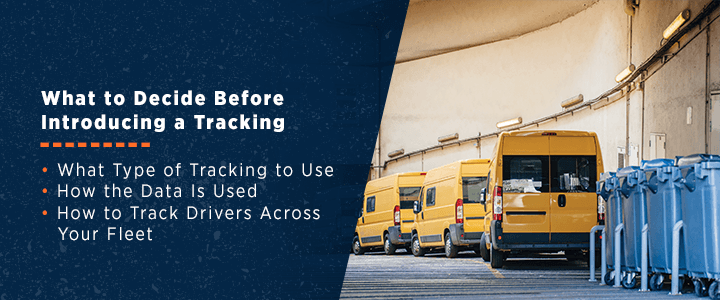
Rolling out a new fleet tracking program and policy means making a variety of decisions before introducing the program to employees. Before bringing employees into it, make sure you have definitive answers to these questions.
The type of tracking you choose will dictate how you communicate it to employees. The biggest decision is whether or not to use covert tracking. With a covert GPS tracking program, devices are typically installed and used in vehicles without the knowledge of employees.
This type of tracking is useful when you suspect a driver is violating company policy and you want to catch them in the act. If you track covertly, you’ll have to make sure no one knows about the new program ahead of time. However, it can result in a backlash if employees find out you’ve started fleet tracking without their knowledge.
You will also be choosing between passive tracking or live GPS tracking. Passive tracking only communicates a few times a day. Live GPS tracking provides near-constant monitoring of the vehicle itself and the behavior of the driver. The more capabilities your tracking system has, the more time you will need to set aside for your explanation and employee questions.
The number one demand from employees when learning about a new fleet tracking system is knowing what you plan to do with the data. A few of your drivers will likely be fearful that you are implementing the new system to weed them out based on small differences in performance data. To get employees to appreciate the bigger picture, you need to clearly codify how you will use the data they generate while doing their jobs.
Will you reprimand employees for failing to reach a certain threshold of productivity? Will you reward the best drivers with bonuses or raises? Presenting a structured plan for how you intend to use data can put employees at ease and allow them to soak up the rest of the information you introduce about the new system.
When you have multiple drivers and multiple vehicles making up your fleet, the more detailed metrics available through Driver Identification technology help bring transparency to the management process. The Dallas Driver ID system provides advanced driver monitoring that allows you to:
When you can run reports by driver as well as vehicle, you never have to waste time figuring out who’s behind the wheel at any given moment. This also means drivers never have to worry about being held accountable for the actions of a different driver, allowing them to focus on safe driving and improving their performance.
Driver ID helps streamline payroll as well, by documenting exactly when each driver starts and ends work. Drivers get peace of mind in knowing their time tracking is accurate, and they can save time they would otherwise spend logging shift information. Dallas Driver ID even generates automatic timesheet reports in multiple formats.
Being able to collect data on drivers as well as vehicles allows you to improve performance based on individual trends, ensuring that you can easily identify your best performers and reward them appropriately. Driver ID is an essential tool for fleets where drivers aren’t assigned to the same vehicle every day.

Even for managers with significant communications experience, the actual act of introducing a new fleet tracking system is a challenge. Picking the right structure and the right words to say can be tricky, but this simple structure offers a helpful scaffolding to build your presentation on.
Introduction of GPS tracking should occur in a face-to-face meeting whenever possible. It can be difficult to gather all your drivers in one place to get things rolling, and you may need to call employees in early or have them stay late to get them all together. If this is the case, consider providing a meal or refreshments as a thank-you for their time. It’s okay if one or two people are missing from the meeting, but the majority of employees and management should be present.
Your introduction should include an honest assessment of why the company has chosen to install the new system. To compete with the best, businesses need to take advantage of powerful new technology that offers a variety of features including:
Some drivers will be resistant to the idea of becoming more accountable or improving their efficiency because they associate these concepts with having to work harder. In reality, fleet tracking makes it possible to achieve better results with less burden. Your next steps will help drive this point home for the more reluctant employees.
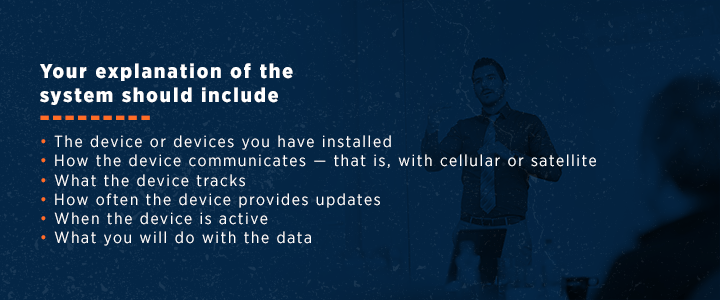
After thanking everyone for taking the time to be present, you can get right to the explanation. This only works if you are confident in your knowledge of the system and software, so be sure you take advantage of any training support your company offers. The first thing you should do is show the device and explain how it works and what type of information you will be collecting. Your explanation of the system should include:
When it comes to explaining what you’ll do with the data provided by the tracking system, it helps to hand out informational sheets with tables that explain the reward or consequence for certain behaviors or productivity levels. The more complex your policy, the more employees will benefit from a visual representation that they can refer to.
Although you may be tempted to create a lengthy presentation that covers all the complexities, be as succinct as possible with your explanation. There will be plenty of questions at the end.
Make it clear that your new system isn’t just a way to produce more profit for the business — it’s truly a win-win for both employees and management. If any incentives are tied to certain behaviors or productivity levels, this is your chance to really sell drivers on the new tech. Even if you don’t plan to offer tracking-based incentives, you can still get a lot of mileage out of benefits like improved safety.
They might not realize it, but most employees need some reassurance when a change this significant occurs. Explaining the benefits helps balance out the natural apprehension associated with adopting new technology. Once employees hear concrete examples of what the technology can do to make their work lives easier, it’s much easier to win them over and get them to follow policy regarding the new system.
Setting up your new system may result in dramatic changes to employee fleet tracking policy that affects drivers. Explaining these changes clearly is key to getting everyone on board with the new system. Your policy should answer these questions in no uncertain terms:
Provide each employee with a copy of the policy so they can read along and note any questions they have. Optimally, your policy is clear enough that with your additional explanation there won’t be any confusion about these “what-ifs.”

No matter how thorough your explanation, there will be questions. They may range from inquiries about how the technology actually works to challenges and minor pushback on the new system. There is a good chance someone will raise a question you don’t know the answer to, so be prepared by creating a list you can take to your GPS tracking company’s support team. These are just a few of the common questions you may run into during this portion of your introductory presentation, along with suggestions for answering.
Q: Why don’t you trust us to do our jobs?
A: We do trust you. It’s a huge responsibility to drive a vehicle and provide products or services to our customers. We’re implementing this new system as a way to better manage the whole fleet, not just one truck. This will allow us to see where we can make overall improvements to operations that will actually make your job easier and more efficient.
Q: Is this even legal?
A: It is. The information we get from the devices is the same information we would get from riding with you on your calls and taking notes, or asking you to write up highly detailed reports. It’s just a way to create and verify information on things like delivery times and miles driven, without you having to lift a finger.
Q: What exactly are you monitoring?
A: The system tracks vehicle start and stop times, length of time spent at each location, driving speed, idling time and total mileage. It also tracks behavior like hard cornering and jackrabbit starts to make sure you’re driving safely.

As a member of management, you want the rollout of a new GPS fleet tracking system to go smoothly and quickly. However, as someone who works directly with employees, you also understand that it can be challenging to facilitate change. Some people will embrace the new efficiencies, while others will remain suspicious and unwilling to recognize the many benefits this new technology will bring them. While it’s up to individuals how they will handle the transition, there are a few things you can do to improve adoption.
It’s also important not to frame tracking implementation as a result of something employees did. Avoid anything that could be construed as an accusation. For example, one of the main benefits of fleet tracking for managers is more precise payroll and elimination of timecard fraud.
However, if you say something like, “The new system will combat potential fraud,” employees might become convinced that you’re accusing one or more of them of being dishonest. Framing the system positively is key in how to introduce GPS fleet tracking to employees successfully.
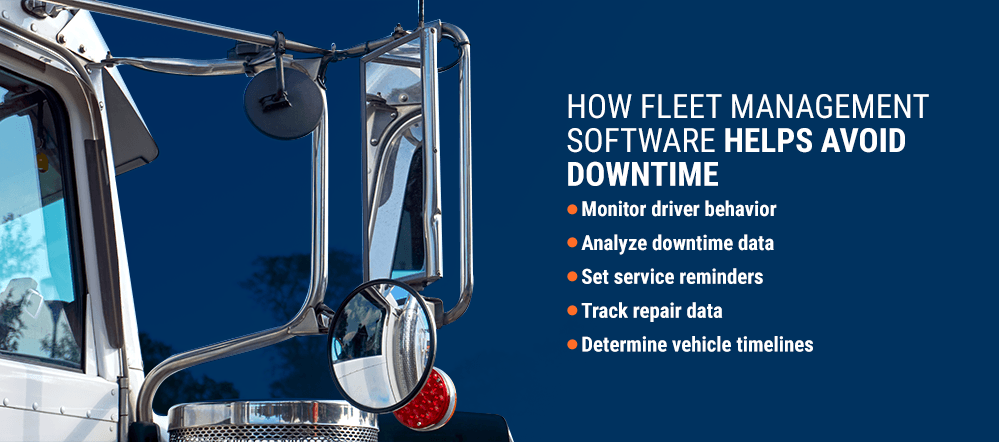
For employees to embrace a new system, they need to understand exactly how it will benefit them on a day-to-day basis. Luckily, you have a ton of advantages to choose from when explaining the benefits of employee GPS fleet tracking for both drivers and managers.
When operations costs get out of hand, businesses often have no choice but to cut their workforce. The cost reductions fleet tracking provides will make your business more profitable and on the path to continued growth. Along with growth comes better job security for employees who are doing good work and adhering to policies. Managers can easily monitor performance and give detailed feedback on reviews, granting employees the opportunity to differentiate themselves based on merit.
When drivers are too focused on getting to their destination as quickly as possible, or when they are attempting to make up for time lost to personal activity on the job, they can exhibit unsafe driving behaviors. When a driver knows the GPS tracking system will alert managers to speeding, hard cornering and jackrabbit starts, they remember that safety is just as important as speed and will reduce their bad habits accordingly. With safer driving and less speeding, your fleet drivers will rack up far fewer traffic violations.
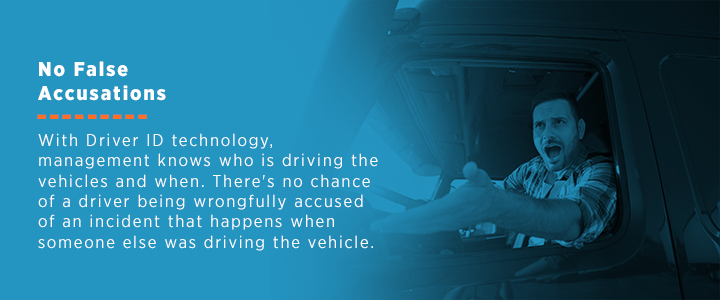
With Driver ID technology, management knows who is driving the vehicles and when. There’s no chance of a driver being wrongfully accused of an incident that happens when someone else was driving the vehicle. The proof of location provided by fleet tracking technology is also helpful if a customer tries to pit their word against your driver’s.
For example, if a customer says they were at home all day and the delivery truck never showed up, you can check the appropriate truck’s logs to see when the driver stopped at the house and attempted delivery.
Filling out forms for time sheets and other information is a task no driver likes or has excess time for. Likewise, you don’t like collecting those forms and putting them into various systems. Quality GPS tracking software comes with reporting features that track all the relevant information and compile it into actionable reports automatically. Your drivers don’t have to track their time or note their starts and stops, and you don’t have to waste time generating reports manually.
One of the central goals of using a GPS fleet tracking system is to get drivers to their destinations faster. The routing capabilities of quality software make this happen in a few different ways. It allows you to improve dispatch by automatically finding the closest driver to a destination, and provides drivers with the fastest route. This function comes in handy when drivers are in unfamiliar areas, and also optimizes familiar routes by helping drivers find alternate paths if there’s an accident or other event causing traffic.
More efficiency reduces the potential for frustration among drivers, dispatchers and managers. But it also increases customer satisfaction. With fewer instances of late arrivals and a greater ability to find out specific ETAs, customers gain more confidence in your company and are more likely to come back and refer you to their friends or family.
GPS tracking can completely transform the way you manage your fleet. Your vehicles, drivers and cargo will all be safer and your company will save money in the process. Introducing fleet tracking to employees may seem like a difficult task, but choosing the right software makes it easy for you to learn the ropes well enough to bring people on board effectively.
Track Your Truck offers superior equipment, software and customer service to your business at a fair price. Our platform is intuitive and easy to learn so you can spend less time on the learning curve and more time making data work for you. If you’re interested in learning more about what makes Track Your Truck different, we invite you to request a free quote.